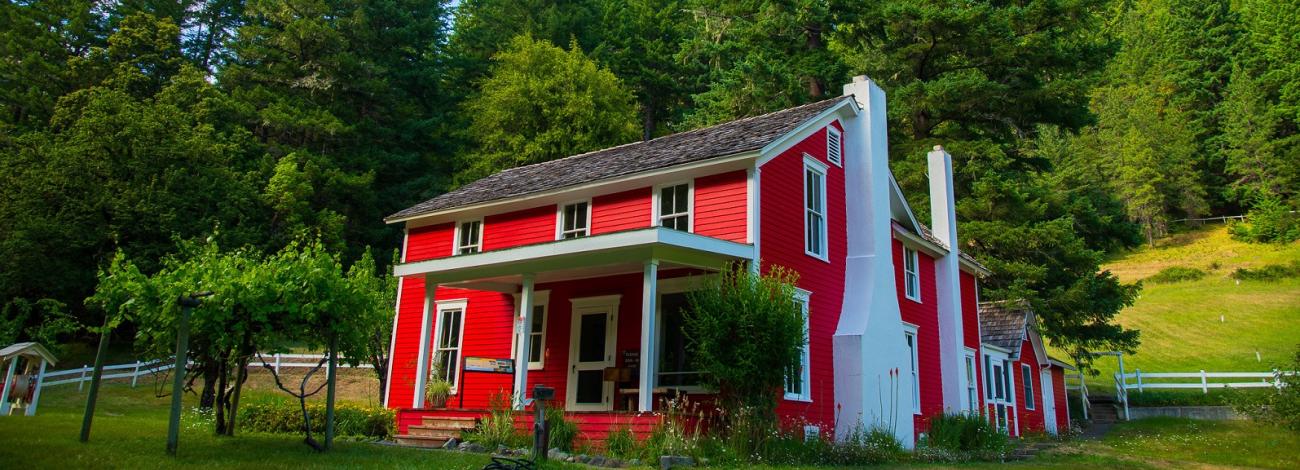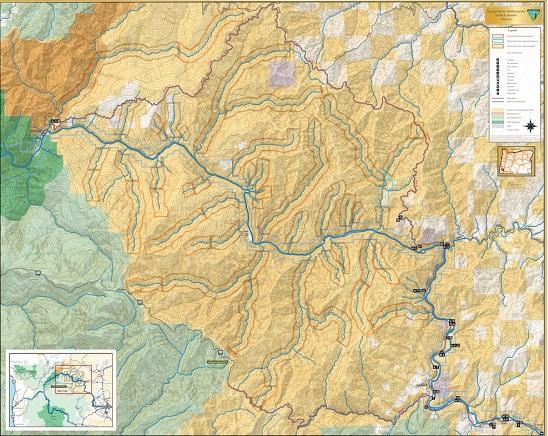
Rogue River History
Rand National Register Listed Site
The Rand National Register Listed Site is located in southwestern Oregon approximately 25 miles northwest of Grants Pass, Oregon, and 3 miles downstream from the community of Galice. Rand is located on a terrace on the west side of the Rogue National Wild and Scenic River in steep, mountainous country with elevations ranging from 700 feet at the river's edge to 4,000 feet on nearby peaks.
Rogue River Ranch
Apply for the Rogue River Ranch Artist in Residence
The Rogue River Ranch is on the National Register of Historic Places and is nestled in the heart of the Rogue River's wild section. Once a major Native American habitation site, the area has enjoyed a rich human history of over 9,000 years. After Europeans arrived, the site evolved into a small gold-mining community, with up to 100 residents trying to scratch a living from the gold-bearing gravel bars of the mighty Rogue River.
The ranch structures remaining today represent the center of the old community, which had a trading post with upstairs lodging, a blacksmith's shop, and numerous outbuildings that filled the early residents' social and commercial needs.
Access
The ranch can be accessed by boating, hiking, or driving. The ranch is 22 river miles and 23 trail miles from Grave Creek. The drive to the ranch is 37 miles from Grave Creek. Most people take two days to float, three days to hike, and two hours to drive to the ranch.
Native Americans
Archeological excavations have shown that Native Americans used the Marial area for gathering at seasonal camps and then later on as permanent camping site. Two different ancient peoples have been noted to frequent the area, the Takelma and the Athabascan. While speaking different languages the basic way of life was the same with hunting, fishing, and gathering being the major occupations. Major food sources were fish, deer, acorns, and camas. The native way of life ended abruptly in 1850s.
Whisky Creek Cabin
Whisky Creek Cabin is one of the few remaining relics of the Rogue River gold rush era. Others have fallen victim to vandalism and the ravages of time. The cabin and surrounding area remains isolated and inaccessible except by river or trail, much like it was when early pioneers first inhabited the area.
In 1973, the Bureau of Land Management purchased the deed to the cabin. Today, Whisky Creek Cabin is on the National Register of Historic Places. It is the oldest known mining cabin, still standing, in the remote lower Rogue River canyon.
Browse around and reflect on the rugged way of life that has long since vanished from this area; but please respect this historic site or it will not be available for others to enjoy.
- Location and Access
Whisky Creek Cabin is in southwest Oregon, within the National Wild and Scenic Rogue River corridor. It can be reached by hiking 3 miles downstream from Grave Creek on the Rogue River National Recreation Trail.
The trail head, at Grave Creek, is 23, paved, road miles, northwest of Interstate 5. Take the Merlin exit, #61, and drive west on the Merlin-Galice Road. There is a small parking area and a toilet at Grave Creek. The toilet is available spring through fall, when the danger of losing it to high water is gone. Overnight parking is illegal at Grave Creek and it can be extremely crowded in the summer time.
The cabin can also be reached by boat. Check with the Smullin Visitor Center at Rand to find out permit requirements for floating the Rogue River below Grave Creek.
- All In A Day's Work
"You see, when you mine for yourself, you don't put 8 hours in. It's 12, 14 hours a day; time you get your breakfast, time you sweep up, do the dishes, then go to work and come in and do your cooking again. Your mind's occupied all the time. In summer you get up about 4:00 a.m. As soon as daylight you go to work. By 11:30 you'd have to quit because down in them canyons it gets hot. If you want to take a day off and go fishing you take a day off and go fishing. Which I did -- for steelhead. After trout it'd be in Whisky Creek, after salmon it'd be the river.
Even in the winter time, though, you're always working. If you can't mine cause the creek's too high, you cut your next year's wood. I had to use a crosscut saw. I despised that thing. I never hit first base with it. But I still had to cut my wood with it, until the chain saws came out. Pile it up, tier it up, and be dry for the next winter. If you're going to stay always have to think ahead. Couldn't be like a grasshopper, play around all summer, wouldn't have nothin'."
Quotes by Ivin Billings, 1976. BLM collection
- A Miner's Life
Miners bought most of their groceries and supplies from mule packers traveling through the area. Lou didn't even keep a garden -- Lou was too busy mining.
"In the fall of the year, I'd get my buck and can it into quart jars. I'd try to find the biggest and fattest one I could find up in the hills. You've got to go up high where they've got food and there's no ticks and they don't move around so much."
Although the miners were, by nature, solitary people, they were always watching out for one another. Sometimes they had to depend on others for help.
"It was always a custom in the hills that whoever came by you'd have a cup of coffee. If we heard something was wrong, we'd go right now, night or day. Otherwise, maybe once a month you'd poke your nose around. That's enough -- an hour and a half. You never stayed too long or you'd wear your welcome out. You soon learned that in the hills."
- Camping
A primitive campground and restroom, located at the mouth of Whisky Creek, are accessible to both hikers and floaters. Water is available from Whisky Creek, although purification is advised.
Big Slide campground, located about 1/2 mile west of Whisky Creek on the Rogue River Trail, is accessed better by trail than by water. It contains a toilet but no water.
- Do Things Yourself
"You learn to do things for yourself when you're in the hills."
"I had no wood on my side of the creek that I could get anywhere at all for firewood. When you're mining you logged your firewood and you logged for your cabin off your claim."
It took less than two weeks for Lou Martin to construct a log retrieval cable and dolly-cart system to get wood across Whisky Creek. Lou strung half-inch steel cable 480 feet across the creek and hand-tightened it with a system of levers and pulleys, a "come-along" and hand winch. The cable came from an old elevator in California.
When in working condition, the cart was powered to the other side of the creek by a "donkey engine." Lou would walk over, cut the wood, load it onto the cart and let gravity take it back across the creek. The cart would pick up so much speed that the impact would jar the load loose, sending logs flying, coming to rest 15 feet from the woodshed where they were stored for the winter.
Lou died in 1977, at the age of 83, after spending most of their last years at this cabin along the Rogue River. In 1976 Lou shared recollections of life in the canyon.
Originally, there was no floor in the main house, but in later years rough fir planking was laid down. This lowered the head room, making the doors substandard height.
- Settling In
Around 1880, an unknown miner built the first cabin at Whisky Creek. The original structure was little more than a crude shelter, consisting of four walls, a dirt floor and a shake roof.
P.H. Rushmore filed the first recorded mining claim in the area in 1917. Rushmore sold the claim to Cy Whiteneck in 1918. Cy improved the cabin by adding a room, laying a floor and constructing the sheds behind the cabin. For several years during their 30-year stay, Cy used hydraulic mining methods at Whisky Creek bar, but the extent of their success is unknown.
Mr. and Mrs. L.M. Nichols purchased the claim from Cy Whiteneck in 1948. The Nichols' hired Lou Martin in 1957 to care for the claim. Lou added many conveniences to improve livability of the cabin. Lou built a solar-heated shower and a double-walled, sawdust-insulated pantry.
The flume ditch near the cabin was constructed about 1890, beginning 1/2 mile up Whisky Creek from the cabin and ending at the gully just behind the tool shed. Later, in 1905, it was extended beyond the cabin to a point about 50 feet above Whisky Creek bar. This flume ditch provided drinking water for the cabin and water for hydraulic mining at both the cabin and bar.


